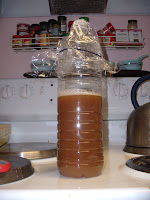Apologies for the lateness of this post.
The partial mash went very well. In a couple weeks, I will be drinking my Steam beer.
Recipe:
~3 lbs of Pale/Gold Malt Extract
1/2 lb of Crystal 40 Malted Barley
2 oz of Maltodextrin powder (non-fermentable sugar that adds body but little to no flavor)
1 oz of Perle pellet hops (3/4 oz boiled for 1 hour, 1/4 oz boiled for 10 minutes)
1 pouch California Lager liquid yeast (made into a starter)
Lots and lots of DC tap water. MMMMM-mmmm

The first thing you do on any brew day is boil a bunch of water. You need boiled water to go in the fermentor, but also to do lots of small little things like rinse off things that need to stay sanitized.

While that's boiling, sanitize all equipment that will touch the wort once it's cool. That means the fermentor, thermometer, stirring spoon (maybe), etc.
Take a gallon of your pre-boiled water and cool it off in a water bath in the sink. It doesn't have to get all the way down to yeast-pitching temp, but you don't want to melt your fermentor, either.
And now, the big new step for a partial mash: Steeping your specialty grain.

There are dozens of kinds of grain that are used in brewing. The variety above is called Crystal 40. It is barley malt that has been kilned at higher temperatures, caramelizing some of the sugars. The number indicates how caramelized/dark it is. Crystal malts range from 20 (very light) to 120 (very dark).

We will steep this grain in 160 degree water for a half hour to extract a bunch of color and flavor. The grain sock is used so that it can be easily removed once steeping is complete.

While steeping, it smelled very sweet and bready. I was also very surprised at how quickly the color of the water changed.
After the grain steeped, brew day proceeded as it usually has for my previous extract batches. We add the Gold Malt Extract syrup:

I added the bulk of the hops at the beginning of the hour long boil. This is the "bittering stage." The alpha acids in the hop isomerize in the hot water, and cut a lot of the malty sweetness of the grain and extract.

Then, with 10 minutes left for the boil, I threw in the last 1/4 oz of hops. This is the "flavor and aroma stage." While the bittering hops' acids are cutting the sweetness, all of the aromatic oils are being boiled away. So in order to have some hoppy taste and smell, we add some hops here at the end of the boil.

Once the boil is over, we quickly chill the wort in a water bath in the sink. Then we pour that chilled wort into the fermentor and add our yeast from the start we made on Wednesday. A lot of liquid had evaporated during the boil, so I added some cooled boiled water to get back up the 2.5 gallon mark.
Give the whole thing a good shake to make sure there's plenty of oxygen for the yeast to party with.

And voila! Our Steam beer is fermenting happily in the Mr. Beer keg. It had a nice, thick kreusen on it by Sunday evening, indicating healthy and vigorous fermentation. Bottling on May 2! Stay tuned!

 Using this, I will be able to mash the grains and then do the subsequent boil for an entire 2.5 gallon batch. No more splitting it up!
Using this, I will be able to mash the grains and then do the subsequent boil for an entire 2.5 gallon batch. No more splitting it up! They were $4 for a two-pack at my neighborhood hardware store. The bag will hold the grain while it steeps in the hot water. Then I can just pull it out, dump the grain, wash the bag, and it's ready to go again.
They were $4 for a two-pack at my neighborhood hardware store. The bag will hold the grain while it steeps in the hot water. Then I can just pull it out, dump the grain, wash the bag, and it's ready to go again.













 I am now letting the least wake up and get happy until this evening. Then, I will pitch the yeast into a starter wort: a small amount of malt that the yeast can eat to power their furious, passionate reproduction. Slow jazz optional.
I am now letting the least wake up and get happy until this evening. Then, I will pitch the yeast into a starter wort: a small amount of malt that the yeast can eat to power their furious, passionate reproduction. Slow jazz optional.




 As the plaid-shirted douche tells us, we should drink Bud Light because of its "drinkability."
As the plaid-shirted douche tells us, we should drink Bud Light because of its "drinkability."